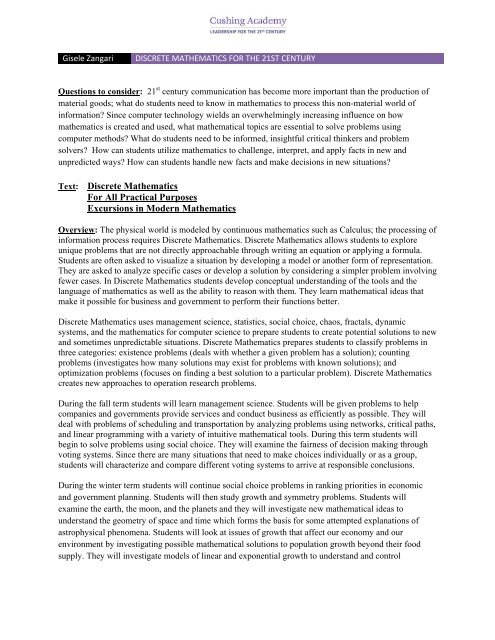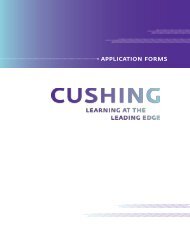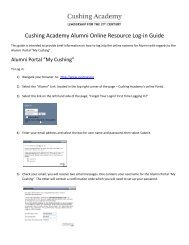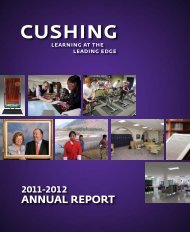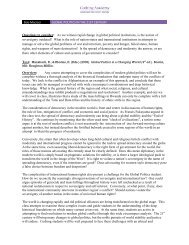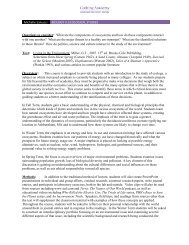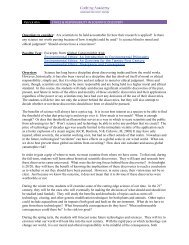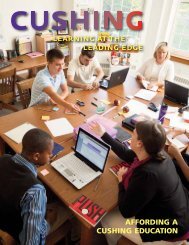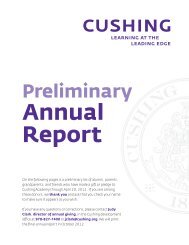Text: Discrete Mathematics For All Practical Purposes Excursions in ...
Text: Discrete Mathematics For All Practical Purposes Excursions in ...
Text: Discrete Mathematics For All Practical Purposes Excursions in ...
You also want an ePaper? Increase the reach of your titles
YUMPU automatically turns print PDFs into web optimized ePapers that Google loves.
Gisele Zangari<br />
DISCRETE MATHEMATICS FOR THE 21ST CENTURY<br />
Questions to consider: 21 st century communication has become more important than the production of<br />
material goods; what do students need to know <strong>in</strong> mathematics to process this non-material world of<br />
<strong>in</strong>formation S<strong>in</strong>ce computer technology wields an overwhelm<strong>in</strong>gly <strong>in</strong>creas<strong>in</strong>g <strong>in</strong>fluence on how<br />
mathematics is created and used, what mathematical topics are essential to solve problems us<strong>in</strong>g<br />
computer methods What do students need to be <strong>in</strong>formed, <strong>in</strong>sightful critical th<strong>in</strong>kers and problem<br />
solvers How can students utilize mathematics to challenge, <strong>in</strong>terpret, and apply facts <strong>in</strong> new and<br />
unpredicted ways How can students handle new facts and make decisions <strong>in</strong> new situations<br />
<strong>Text</strong>: <strong>Discrete</strong> <strong>Mathematics</strong><br />
<strong>For</strong> <strong>All</strong> <strong>Practical</strong> <strong>Purposes</strong><br />
<strong>Excursions</strong> <strong>in</strong> Modern <strong>Mathematics</strong><br />
Overview: The physical world is modeled by cont<strong>in</strong>uous mathematics such as Calculus; the process<strong>in</strong>g of<br />
<strong>in</strong>formation process requires <strong>Discrete</strong> <strong>Mathematics</strong>. <strong>Discrete</strong> <strong>Mathematics</strong> allows students to explore<br />
unique problems that are not directly approachable through writ<strong>in</strong>g an equation or apply<strong>in</strong>g a formula.<br />
Students are often asked to visualize a situation by develop<strong>in</strong>g a model or another form of representation.<br />
They are asked to analyze specific cases or develop a solution by consider<strong>in</strong>g a simpler problem <strong>in</strong>volv<strong>in</strong>g<br />
fewer cases. In <strong>Discrete</strong> <strong>Mathematics</strong> students develop conceptual understand<strong>in</strong>g of the tools and the<br />
language of mathematics as well as the ability to reason with them. They learn mathematical ideas that<br />
make it possible for bus<strong>in</strong>ess and government to perform their functions better.<br />
<strong>Discrete</strong> <strong>Mathematics</strong> uses management science, statistics, social choice, chaos, fractals, dynamic<br />
systems, and the mathematics for computer science to prepare students to create potential solutions to new<br />
and sometimes unpredictable situations. <strong>Discrete</strong> <strong>Mathematics</strong> prepares students to classify problems <strong>in</strong><br />
three categories: existence problems (deals with whether a given problem has a solution); count<strong>in</strong>g<br />
problems (<strong>in</strong>vestigates how many solutions may exist for problems with known solutions); and<br />
optimization problems (focuses on f<strong>in</strong>d<strong>in</strong>g a best solution to a particular problem). <strong>Discrete</strong> <strong>Mathematics</strong><br />
creates new approaches to operation research problems.<br />
Dur<strong>in</strong>g the fall term students will learn management science. Students will be given problems to help<br />
companies and governments provide services and conduct bus<strong>in</strong>ess as efficiently as possible. They will<br />
deal with problems of schedul<strong>in</strong>g and transportation by analyz<strong>in</strong>g problems us<strong>in</strong>g networks, critical paths,<br />
and l<strong>in</strong>ear programm<strong>in</strong>g with a variety of <strong>in</strong>tuitive mathematical tools. Dur<strong>in</strong>g this term students will<br />
beg<strong>in</strong> to solve problems us<strong>in</strong>g social choice. They will exam<strong>in</strong>e the fairness of decision mak<strong>in</strong>g through<br />
vot<strong>in</strong>g systems. S<strong>in</strong>ce there are many situations that need to make choices <strong>in</strong>dividually or as a group,<br />
students will characterize and compare different vot<strong>in</strong>g systems to arrive at responsible conclusions.<br />
Dur<strong>in</strong>g the w<strong>in</strong>ter term students will cont<strong>in</strong>ue social choice problems <strong>in</strong> rank<strong>in</strong>g priorities <strong>in</strong> economic<br />
and government plann<strong>in</strong>g. Students will then study growth and symmetry problems. Students will<br />
exam<strong>in</strong>e the earth, the moon, and the planets and they will <strong>in</strong>vestigate new mathematical ideas to<br />
understand the geometry of space and time which forms the basis for some attempted explanations of<br />
astrophysical phenomena. Students will look at issues of growth that affect our economy and our<br />
environment by <strong>in</strong>vestigat<strong>in</strong>g possible mathematical solutions to population growth beyond their food<br />
supply. They will <strong>in</strong>vestigate models of l<strong>in</strong>ear and exponential growth to understand and control
Gisele Zangari<br />
DISCRETE MATHEMATICS FOR THE 21ST CENTURY<br />
epidemics and phenomena. Students will also <strong>in</strong>vestigate growth and symmetry us<strong>in</strong>g spiral growth,<br />
Fibonacci Numbers, growth of populations, symmetry of motion, and symmetry of scale and fractals.<br />
In the spr<strong>in</strong>g term the students will study statistics and computer science. The future is filled with<br />
uncerta<strong>in</strong>ty and a way to reduce the uncerta<strong>in</strong>ty is to gather <strong>in</strong>formation perta<strong>in</strong><strong>in</strong>g to a particular situation<br />
and analyze the data. Students will design surveys and experiments which will produce accurate<br />
<strong>in</strong>formation and the unbiased <strong>in</strong>terpretation of the data. Students will collect data and organize data, and<br />
use descriptive statistics, probability and normal distribution. Students will also <strong>in</strong>vestigate computer<br />
science by develop<strong>in</strong>g algorithms and <strong>in</strong>vestigate encod<strong>in</strong>g <strong>in</strong>formation.<br />
Methods: Through open-ended problems, the students will gather data us<strong>in</strong>g real-time download from<br />
NASA on space and earth, record and organize this data, explore and discover patterns and conjecture.<br />
Students will be encouraged to connect related topics, develop new algorithms and alternate methods of<br />
display<strong>in</strong>g and process<strong>in</strong>g <strong>in</strong>formation. <strong>For</strong> example, students will approach formerly unapproachable<br />
problems us<strong>in</strong>g dynamical systems. Examples of dynamical systems are the weather, the fluctuation of the<br />
stock market average, chemical reactions, and the motion of planets.<br />
In do<strong>in</strong>g so, the students will be learn<strong>in</strong>g to:<br />
1. Develop several strategies <strong>in</strong> solv<strong>in</strong>g a problem and identify the optimal solution.<br />
2. Gather data, record data, identify patterns, listen carefully and communicate the processes at<br />
arriv<strong>in</strong>g at a solution.<br />
3. Recognize situations appropriate for mathematical models and use these models for f<strong>in</strong>d<strong>in</strong>g<br />
optimal solutions.<br />
4. Identify a variety of sett<strong>in</strong>gs where <strong>Discrete</strong> <strong>Mathematics</strong> problems arise.<br />
Possible Issues:<br />
1. FALL TERM: Management Science<br />
a. Network Theory<br />
b. Euler and Hamiltonian Circuits<br />
c. Spann<strong>in</strong>g and Ste<strong>in</strong>er Trees<br />
d. Schedul<strong>in</strong>g Problems<br />
2. WINTER TERM: Social Choice and Growth & Symmetry<br />
a. Vot<strong>in</strong>g Methods<br />
b. Fair Division<br />
c. Spiral Growth<br />
d. Fibonacci Numbers<br />
e. Symmetry of Scale & Fractals<br />
f. Chaos<br />
g. Dynamic Systems<br />
3. SPRING TERM: Statistics and Computer Science<br />
a. Collect<strong>in</strong>g and Organiz<strong>in</strong>g Data<br />
b. Descriptive Statistics<br />
c. Probability<br />
d. Algorithms<br />
e. Encod<strong>in</strong>g Information
Gisele Zangari<br />
DISCRETE MATHEMATICS FOR THE 21ST CENTURY


